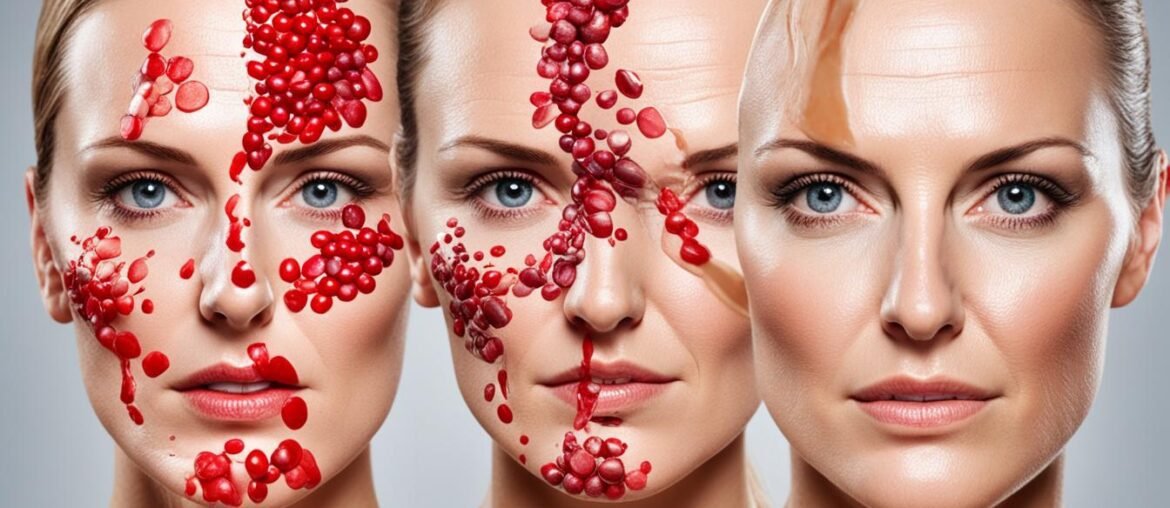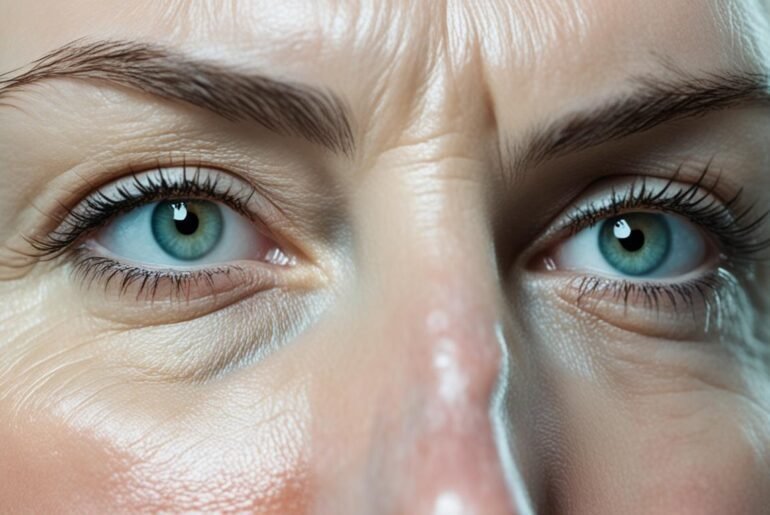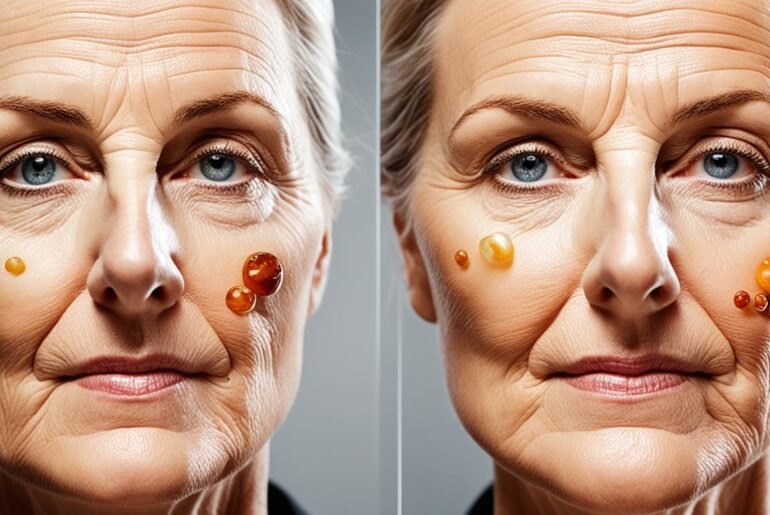Did you know that alcohol consumption can have a profound impact on the health and appearance of your skin? It’s not just excessive drinking that can cause skin damage; even moderate alcohol consumption can lead to oxidative stress, a process that accelerates skin aging and impairs its overall health.
Oxidative stress occurs when there is an imbalance between the production of harmful reactive oxygen species (ROS) and the body’s ability to detoxify them. Alcohol promotes the generation of ROS and interferes with the body’s natural defense mechanisms against these compounds.
But what exactly is oxidative stress, and how does alcohol contribute to it? In this article, we will explore the effects of alcohol on the skin, the mechanisms behind alcohol-induced oxidative stress, and the implications for skin health and aging. Understanding the relationship between alcohol and oxidative stress is crucial for preserving the vitality and well-being of your skin.
Key Takeaways:
- Alcohol consumption can lead to oxidative stress in the skin, accelerating the aging process and causing damage.
- Reactive oxygen species (ROS) are harmful compounds produced when alcohol is metabolized in the body.
- Alcohol interferes with the body’s natural defense mechanisms against ROS, leading to an imbalance.
- Oxidative stress in the skin can result in wrinkles, fine lines, age spots, and other signs of premature aging.
- Maintaining a balanced oxidative state and limiting alcohol consumption are essential for protecting skin health.
Understanding Alcohol Metabolism and Oxidative Stress
Alcohol metabolism is a complex process involving enzymes such as cytochrome P450 and alcohol dehydrogenase. These enzymes play a crucial role in the breakdown of alcohol in the body. However, this metabolic process also contributes to the production of reactive oxygen species (ROS) and oxidative stress.
When alcohol is metabolized, it generates reactive oxygen species that can cause damage to cellular molecules, including proteins and DNA. These ROS are highly reactive and can initiate a chain reaction of oxidative damage within cells. This oxidative stress can lead to cell injury and dysfunction.
Furthermore, alcohol consumption can disrupt the balance between ROS production and elimination. One way it does this is by reducing the levels of antioxidants in the body. Antioxidants are responsible for neutralizing and eliminating ROS, but alcohol impairs their functioning, leaving the body more susceptible to oxidative stress.
The combination of increased ROS production and decreased antioxidant levels results in an imbalance that promotes oxidative stress and cell injury.
“Alcohol metabolism contributes to the production of reactive oxygen species and oxidative stress, which can lead to cell injury and dysfunction.”
The Role of Cytochrome P450
Cytochrome P450 enzymes, in particular, play a significant role in alcohol metabolism and the subsequent generation of reactive oxygen species. These enzymes are responsible for breaking down alcohol into various metabolites, some of which contribute to the production of ROS.
One of the metabolites produced by cytochrome P450 is acetaldehyde, a highly reactive compound. Acetaldehyde reacts with oxygen to generate more reactive oxygen species, further amplifying oxidative stress in the body.
The Impact on Antioxidant Levels
Another crucial aspect of alcohol metabolism and oxidative stress is the effect it has on antioxidant levels. Antioxidants, such as vitamins C and E, play a vital role in counteracting the damaging effects of reactive oxygen species.
However, alcohol consumption reduces the levels of antioxidants in the body. This reduction impairs the body’s ability to eliminate ROS effectively, leading to an accumulation and subsequent tissue damage.
Furthermore, alcohol-induced oxidative stress can deplete the body’s antioxidant reserves, making it even more susceptible to the damaging effects of reactive oxygen species.
| Effect | Alcohol Metabolism | Oxidative Stress |
|---|---|---|
| Increased production of reactive oxygen species (ROS) | Cytochrome P450 enzymes break down alcohol, generating ROS | Oxidative stress damages cellular molecules, leading to cell injury |
| Disruption of antioxidant levels | Alcohol reduces antioxidant levels in the body | Reduced antioxidant levels impair the body’s ability to eliminate ROS |
In summary, alcohol metabolism contributes to the production of reactive oxygen species (ROS) and oxidative stress. The breakdown of alcohol by enzymes such as cytochrome P450 generates ROS, while alcohol reduces antioxidant levels, creating an imbalance between ROS production and elimination. This oxidative stress can lead to cellular damage and dysfunction. Understanding the mechanisms behind alcohol-induced oxidative stress is essential for developing strategies to mitigate its harmful effects.
The Impact of Alcohol on Skin Aging
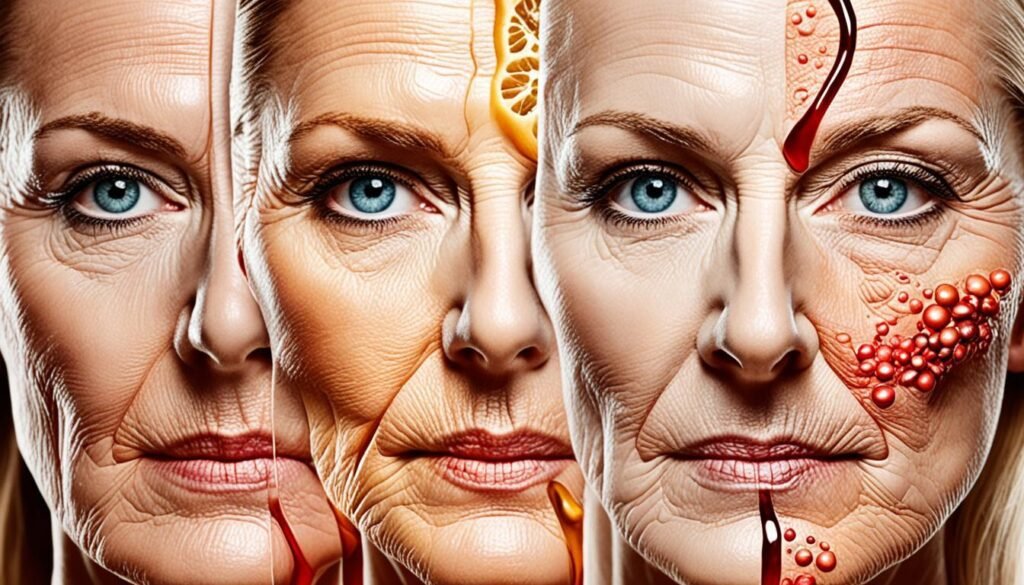
The effects of alcohol consumption on skin aging are significant. Both acute and chronic exposure to alcohol can lead to the production of reactive oxygen species (ROS) in the skin, causing oxidative stress. This oxidative stress contributes to various signs of skin aging, including the formation of wrinkles, fine lines, and age spots. Alcohol-induced oxidative stress also damages other tissues throughout the body, such as muscle, pancreas, and nerve cells.
Oxidative stress is a result of an imbalance between the production of ROS and the body’s ability to neutralize them with antioxidants. Alcohol promotes the production of ROS in the skin, leading to lipid peroxidation and damage to proteins and DNA. Over time, this damage accumulates and contributes to the visible signs of skin aging.
Furthermore, alcohol-induced oxidative stress can impair the skin’s natural repair mechanisms and disrupt collagen production. Collagen is a vital protein that provides structure and elasticity to the skin. When collagen fibers are damaged or depleted, the skin loses its firmness and resilience, resulting in sagging and drooping.
It is important to note that the effects of alcohol on skin aging are not limited to external factors. Studies have shown that alcohol-induced oxidative stress can negatively impact the overall health and function of skin cells, influencing their ability to regenerate and repair. This can further contribute to the accelerated aging process.
Oxidative stress plays a central role in the development of skin aging. Alcohol consumption increases the production of reactive oxygen species (ROS) in the skin, leading to damage to lipids, proteins, and DNA. This oxidative stress contributes to the visible signs of aging and compromises the overall health of the skin.
To maintain youthful and healthy skin, it is crucial to reduce alcohol consumption and minimize exposure to oxidative stress. Implementing lifestyle changes and incorporating antioxidant-rich skincare products can help protect the skin from the damaging effects of alcohol-induced oxidative stress.
Skin Aging and Alcohol: A Comparative Analysis
| Acute Alcohol Exposure | Chronic Alcohol Exposure | |
|---|---|---|
| ROS Production | Elevated due to increased alcohol metabolism | Sustained elevation due to long-term alcohol consumption |
| Oxidative Stress | Temporary increase | Chronic and persistent |
| Effect on Collagen | Temporary disruption | Impaired collagen synthesis |
| Skin Damage | Short-term effects | Cumulative damage over time |
| Visible Signs of Aging | Temporary appearance of fine lines and wrinkles | Pronounced wrinkling, sagging, and age spots |
- Elevated ROS production occurs as a result of increased alcohol metabolism in the body. While acute exposure leads to temporary effects, chronic alcohol consumption sustains elevated ROS production.
- Oxidative stress is a temporary occurrence with acute alcohol exposure but becomes chronic and persistent with long-term consumption.
- The impact on collagen is temporary when exposed to alcohol acutely but becomes impaired over time, leading to decreased collagen synthesis with chronic exposure.
- Skin damage from alcohol is primarily short-term with acute exposure but accumulates over time, resulting in cumulative damage and accelerated aging with chronic consumption.
- The visible signs of skin aging, such as fine lines, wrinkles, and age spots, are temporary and less pronounced with acute exposure but become more significant with chronic alcohol intake.
The Role of Alcohol in Skin Damage
Alcohol consumption can have detrimental effects on the health and appearance of the skin. One of the major contributors to these negative effects is alcohol-induced oxidative stress, which damages skin cells and disrupts cellular processes.
When alcohol is metabolized in the body, it generates reactive oxygen species (ROS), which are highly reactive molecules that can cause significant damage to cellular structures. The production of ROS leads to various forms of skin damage, including:
- DNA damage
- Lipid peroxidation
- Protein damage
Oxidative stress caused by alcohol-induced cell injury not only affects the skin but also compromises overall skin health. It can disrupt the balance between free radicals and antioxidants, further exacerbating the damage to skin cells.
Protecting the skin from alcohol-induced oxidative stress is essential for maintaining skin health. Antioxidants play a crucial role in neutralizing the harmful effects of ROS. They help to prevent oxidative damage and maintain the integrity of skin cells.
The importance of antioxidants
Antioxidants, such as vitamins C and E, help to counteract the harmful effects of oxidative stress on the skin. They scavenge free radicals and minimize cell damage, promoting healthier and more resilient skin.
Moreover, antioxidants stimulate collagen synthesis and promote skin repair and regeneration. They also assist in maintaining the skin’s moisture barrier, reducing inflammation and redness, and enhancing overall skin health.
“The damaging effects of alcohol-induced oxidative stress on the skin can be mitigated by incorporating antioxidant-rich skincare products into your routine. These products can help to neutralize free radicals and protect the skin from further damage.”
Minimizing alcohol-induced skin damage
To minimize the damage caused by alcohol-induced oxidative stress, it is important to reduce alcohol consumption and adopt a skincare routine that focuses on protecting and repairing the skin. This routine should include:
- Gentle cleansing to remove impurities and environmental toxins
- Regular exfoliation to promote cell turnover and renewal
- Application of antioxidant-rich serums and moisturizers
- Consistent use of broad-spectrum sunscreen to shield the skin from UV damage
By incorporating these practices into your skincare routine and limiting alcohol consumption, you can help minimize the negative effects of alcohol-induced oxidative stress on your skin and promote skin health.
The Connection Between Alcohol and Skin Oxidative Imbalance

Alcohol consumption has profound effects on the oxidative balance within the skin. By promoting the production of reactive oxygen species (ROS) and reducing antioxidant levels, alcohol disrupts the delicate equilibrium necessary for healthy skin. This oxidative imbalance leads to oxidative stress, which can result in cell injury and damage to various skin components.
While visible signs of aging, such as wrinkles and fine lines, may be the most apparent effects of alcohol-induced oxidative stress on the skin, the consequences go much deeper. Numerous studies have demonstrated the detrimental impact of alcohol on overall skin health.
For instance, alcohol-induced oxidative stress can accelerate the aging process and contribute to the development of age-related skin conditions. The production of ROS, combined with the reduction of antioxidant defenses, leaves the skin vulnerable to oxidative damage. This damage can manifest in the form of DNA and protein injury, lipid peroxidation, and impaired cellular functions.
It is crucial to understand that the effects of alcohol on skin health extend beyond aesthetics. The skin serves as a protective barrier, and its condition is vital to overall well-being. Alcohol-induced oxidative imbalance compromises the skin’s ability to defend against external factors, making it more susceptible to infections, inflammation, and other forms of damage.
To visualize the impact of alcohol on skin oxidative imbalance, refer to the table below:
| Effects of Alcohol on Skin Oxidative Imbalance | Effects on Skin Health |
|---|---|
| Promotes the production of reactive oxygen species (ROS) | Increases oxidative stress and cell injury |
| Reduces antioxidant levels | Compromises skin’s defense against oxidative damage |
| Impairs DNA and protein integrity | Increases the risk of skin aging and related conditions |
| Enhances lipid peroxidation | Leads to tissue damage and impaired cellular functions |
Protecting skin health from alcohol-induced oxidative stress requires a comprehensive approach. Limiting alcohol consumption and adopting a balanced lifestyle are crucial steps in preserving the vitality and resilience of the skin. Additionally, promoting a diet rich in antioxidants and implementing skincare routines that replenish and nourish the skin can help mitigate the effects of alcohol-induced oxidative imbalance.
Understanding the Mechanisms of Alcohol-Induced Oxidative Stress
Alcohol-induced oxidative stress occurs through various mechanisms that contribute to the production of reactive oxygen species (ROS) in the body. These mechanisms include alcohol metabolism, the breakdown of alcohol molecules, and the stimulation of certain enzymes.
When alcohol is metabolized in the liver, it generates reactive byproducts that further contribute to the production of ROS. This oxidative stress can damage cells and tissues throughout the body, including the skin.
One important mechanism involved in alcohol-induced oxidative stress is the activity of cytochrome P450 enzymes. These enzymes are responsible for metabolizing alcohol and other substances in the body. However, their activity also leads to the production of ROS.
“The breakdown of alcohol by cytochrome P450 enzymes contributes to the production of reactive oxygen species, which can have detrimental effects on our cells and tissues.”
In addition to ROS production, alcohol consumption alters the levels of antioxidants in the body. Antioxidants help neutralize ROS and protect cells from oxidative damage. When antioxidant levels are reduced, the balance between ROS production and elimination is disrupted, leading to increased oxidative stress.
The Role of Alcohol Metabolism
Alcohol metabolism plays a central role in the mechanisms of alcohol-induced oxidative stress. When alcohol is consumed, it is primarily metabolized in the liver by enzymes such as alcohol dehydrogenase and cytochrome P450. This metabolism generates reactive byproducts, such as acetaldehyde, that contribute to ROS production.
Furthermore, alcohol metabolism leads to the alteration of antioxidant levels. Studies have shown that chronic alcohol consumption decreases the levels of antioxidants, such as glutathione, vitamin C, and vitamin E, in various tissues.
- Acetaldehyde production: The breakdown of alcohol generates acetaldehyde, a toxic byproduct that contributes to ROS production.
- Antioxidant depletion: Chronic alcohol consumption reduces the levels of antioxidants, leading to an increased imbalance between ROS production and elimination.
- Cytochrome P450 stimulation: Alcohol stimulates the activity of cytochrome P450 enzymes, which are involved in ROS production.
Understanding the mechanisms of alcohol-induced oxidative stress is crucial for comprehending its effects on the body and developing strategies to mitigate its impact.
The Effects of Alcohol on Periodontal Structures
Alcohol consumption can have significant negative effects on the health of periodontal structures. It has been associated with the development of oral diseases, including gingival margin recession and alterations in the oral mucosae. While the direct effects of alcohol on dental tissues are not yet fully understood, research suggests that the combined influence of alcohol with other factors such as vitamin/nutrient deficiencies and smoking can contribute to poor periodontal health.
Periodontal health is crucial for maintaining dental stability and overall oral well-being. The integrity and strength of periodontal structures play a vital role in supporting healthy teeth and preventing conditions such as gum disease. However, alcohol consumption may have a detrimental impact on dental stability and the outcome of orthodontic treatment.
To understand the potential effects of alcohol on periodontal health, it is essential to consider the various factors at play. Alcohol-induced oral diseases may manifest through the following mechanisms:
- Direct tissue damage: Alcohol may directly damage the oral tissues, leading to inflammation and compromised oral health.
- Compromised immune response: Alcohol consumption can weaken the immune system, making individuals more susceptible to oral infections.
- Nutritional deficiencies: Excessive alcohol consumption is often associated with poor nutrition, which can contribute to oral health issues.
- Smoking: The combination of alcohol and smoking exacerbates the negative impact on periodontal tissues, increasing the risk of gum disease and other oral health problems.
It is crucial for individuals to be aware of these potential risks and take necessary steps to maintain good periodontal health. Implementing oral hygiene practices such as regular brushing, flossing, and routine dental check-ups can help mitigate the impact of alcohol-induced oral diseases.
“Alcohol consumption can weaken the immune system and exacerbate the negative effects of other risk factors, such as poor nutrition and smoking, on periodontal health.”
Furthermore, seeking professional guidance from a dentist or periodontist can provide valuable insights into maintaining dental stability while consuming alcohol. They can offer personalized advice and treatment options to address the specific needs and concerns associated with alcohol-related periodontal issues.
It’s essential to recognize that maintaining optimal periodontal health goes beyond avoiding excessive alcohol consumption. Other lifestyle factors, such as a balanced diet, regular exercise, and avoiding tobacco use, contribute to overall oral health and well-being. Taking a comprehensive approach to oral care is integral to preserving dental stability and preventing alcohol-induced oral diseases.
Alcohol’s Impact on Extracellular Matrix and Bone Dynamics
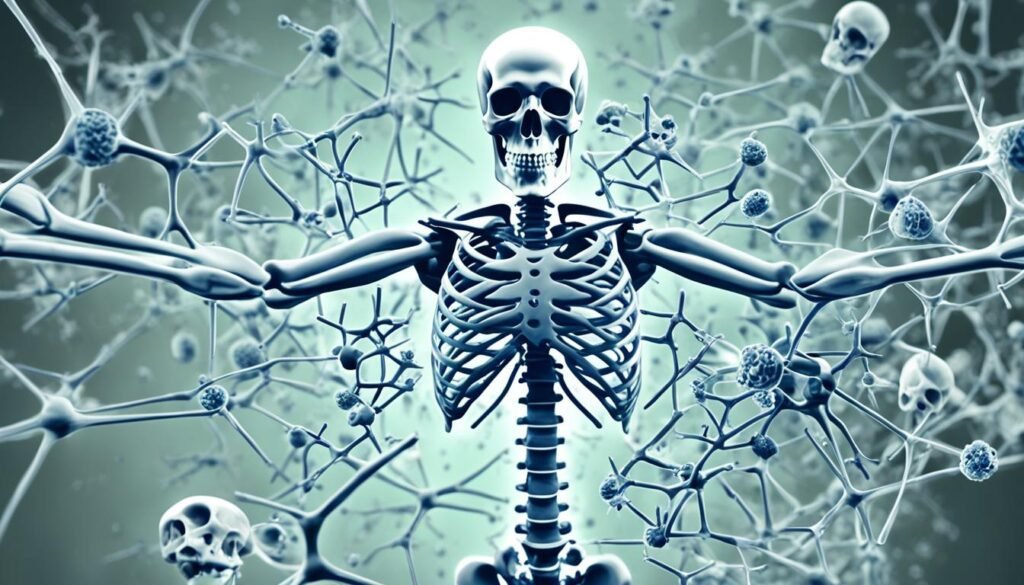
Alcohol consumption can have detrimental effects on the extracellular matrix and bone dynamics. The excessive intake of alcohol promotes the production of reactive oxygen species (ROS) and lipid peroxidation.
This oxidative stress leads to the degradation of collagen and bone resorption, impairing the overall health and stability of the skeletal system. Alcohol’s influence on osteoblasts, the cells responsible for bone formation, exacerbates these damaging effects.
By disrupting the extracellular matrix and bone dynamics, alcohol consumption increases the risk of osteoporosis, bone fractures, and impaired bone healing. Maintaining a healthy bone structure is crucial for overall well-being and mobility.
Effects of Alcohol on Extracellular Matrix and Bone Dynamics
The harmful effects of alcohol on the extracellular matrix and bone dynamics are multifaceted and consequential. Here are the key ways alcohol negatively impacts bone health:
- Increased Reactive Oxygen Species (ROS) Production: Alcohol consumption leads to an overproduction of ROS, which damages collagen and other structural proteins in the extracellular matrix.
- Lipid Peroxidation: Alcohol-induced oxidative stress promotes lipid peroxidation, further compromising the integrity of the extracellular matrix and bone tissue.
- Bone Resorption: Alcohol disrupts the delicate balance between bone formation and resorption. It enhances bone resorption, resulting in a net loss of bone mass and decreased bone density.
- Impaired Osteoblast Function: Alcohol’s influence on osteoblasts inhibits their differentiation and mineralization capabilities, impairing the formation of new bone tissue.
| Effect of Alcohol on Bone | Summary |
|---|---|
| Increased production of reactive oxygen species (ROS) | Leads to collagen degradation and compromised structural integrity |
| Lipid peroxidation | Causes further damage to the extracellular matrix and bone tissue |
| Enhanced bone resorption | Results in decreased bone density and increased risk of osteoporosis |
| Impaired osteoblast function | Reduces the ability to form new bone tissue |
It is clear that alcohol’s impact on the extracellular matrix and bone dynamics can have significant consequences for skeletal health. Avoiding excessive alcohol consumption and adopting a healthy lifestyle can help maintain strong and resilient bones.
Conclusion
The consumption of alcohol has a significant impact on skin health, contributing to oxidative stress and accelerating the aging process. This oxidative stress arises from the production of reactive oxygen species (ROS) and the disruption of antioxidant levels in the body. Understanding the detrimental effects of alcohol on the skin is vital to developing strategies that can protect against alcohol-induced oxidative stress.
Protecting skin health from alcohol-induced oxidative stress requires implementing measures to maintain a balanced oxidative state and limit alcohol consumption. By reducing alcohol intake, individuals can minimize the production of ROS and the subsequent damage to skin cells. Additionally, adopting a lifestyle that promotes antioxidant-rich foods and skincare products can help counteract the effects of alcohol on skin health.
To preserve skin vitality and overall well-being, it is crucial to recognize the role of alcohol in oxidative stress and take proactive steps toward protecting the skin. By prioritizing skin health, individuals can make informed choices about their alcohol consumption and implement strategies to mitigate the negative impact of alcohol-induced oxidative stress on the skin.
FAQ
How does alcohol contribute to oxidative stress in the skin?
Alcohol promotes the generation of reactive oxygen species (ROS) and interferes with the body’s normal defense mechanisms against these compounds. It stimulates cytochrome P450 enzymes that contribute to ROS production and alters the levels of certain metals in the body, facilitating ROS production. Alcohol also reduces the levels of antioxidants, leading to oxidative stress in cells.
What are the effects of alcohol on skin aging?
Both acute and chronic alcohol exposure can increase the production of reactive oxygen species (ROS) and enhance the peroxidation of lipids, proteins, and DNA in the skin. This oxidative stress contributes to skin aging, including the formation of wrinkles, fine lines, and age spots.
How does alcohol damage the skin?
Alcohol-induced oxidative stress can damage skin cells, leading to various forms of skin damage. This includes DNA damage, lipid peroxidation, and protein damage. The production of reactive oxygen species (ROS) contributes to cell injury and can disrupt cellular processes. Alcohol’s negative impact on antioxidant levels further exacerbates the damage caused by oxidative stress.
What is the connection between alcohol and skin oxidative imbalance?
Alcohol consumption contributes to oxidative imbalance in the skin by promoting the production of reactive oxygen species (ROS) and reducing antioxidant levels. This imbalance leads to oxidative stress and can result in cell injury. The effects of alcohol on skin health go beyond visible signs of aging and can impact the overall well-being of the skin.
How does alcohol induce oxidative stress?
Alcohol induces oxidative stress through various mechanisms. It promotes the production of reactive oxygen species (ROS) through alcohol metabolism in the liver. The breakdown of alcohol results in the formation of molecules that further contribute to ROS production. Additionally, alcohol stimulates the activity of cytochrome P450 enzymes, which are involved in ROS production.
What are the effects of alcohol on periodontal structures?
Alcohol consumption can have detrimental effects on periodontal structures. It can contribute to oral diseases, including gingival margin recession and oral mucosae alterations. The direct effects of alcohol on dental tissues are not well-studied, but the combined influence of alcohol and other factors, such as vitamin/nutrient deficiencies and smoking, can lead to poor periodontal health.
How does alcohol impact extracellular matrix and bone dynamics?
Alcohol consumption can disrupt the extracellular matrix and bone dynamics. It promotes the production of reactive oxygen species (ROS) and lipid peroxidation, leading to the degradation of collagen and bone resorption. Alcohol’s influence on osteoblasts and other cells involved in bone remodeling can further contribute to these damaging effects.
What can I do to protect my skin from alcohol-induced oxidative stress?
Protecting skin cells from alcohol-induced oxidative stress is crucial for maintaining skin health. Implementing measures to maintain a balanced oxidative state and limit alcohol consumption can help preserve skin vitality and overall well-being.

